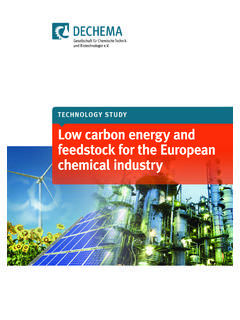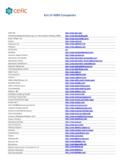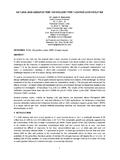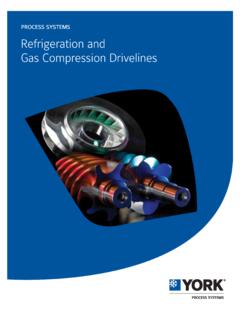Transcription of Chemical Logistics Vision 2020 - Cefic | European …
1 Chemical Logistics Vision 2020 September, 2011 The next decade s key trends, impacts and solution areas 2011 Deloitte Introduction The Chemical industry is an important driver of the global economy, with estimated global annual sales of 1871 billion in 2009. The EU remains a leading chemicals production area, valued at 449 billion and accounting for 24 per cent of world chemicals production in 2009. Europe s share of the global chemicals production dropped however from 32 to 24 per cent between 1999 and 2009, due to stronger growth in other parts of the world.
2 Logistics are a key aspect of the Chemical industry as production and consumption locations are mostly separated. Efficient, competitive and sustainable Logistics are therefore of great importance for its future development. Logistics are typically quite agile, flexible and adjustable and as such, provide opportunities to respond to market changes quickly and effectively. This report is the final output of a review initiated by the Strategy Implementation Group Logistics (SIG Logistics ) of Cefic to create a Vision of European Chemical Logistics over the next decade.
3 This review started with a workshop on 18 October 2010, attended by 15 Logistics managers from key players in the Chemical industry and facilitated by Deloitte. The scope encompassed Chemical Logistics by all modes of transport in Europe. The future was depicted from three different perspectives: the Chemical industry, the Logistics industry and external factors ( sustainability and regulations). The output from the workshop was then combined with the findings from the Deloitte Chemicals 2020 resulting draft report was reviewed at meetings of the Cefic SIG Logistics in February and June 2011.
4 The present report gives an overview of likely key trends in the next decade impacting Chemical Logistics as a whole. The solutions proposed provide food for thought to trigger further discussion on these issues. Likewise, it will help Logistics managers in the Chemical and Logistics industry along the road towards 2020. Source: Cefic Facts and Figures 2010 - The European Chemical Industry in a worldwide perspective 1 2011 Deloitte The purpose of this report is to describe the likely trends in European Chemical Logistics towards 2020 2 This report describes major trends and their impact on European Chemical Logistics based on historical evolution and likely future developments in the industry while taking account of external factors such as regulatory changes.
5 This report should help shippers and Logistics Service Providers (LSPs) to reflect on the challenges ahead. The aim is to stimulate thinking about future developments in European Chemical Logistics . The described solution areas are only indicative and need further elaboration. Purpose 2011 Deloitte Recap of approach and findings of the Chemical Logistics Vision 2020 Key trends Product flows in 2020 will continue to evolve. The role of developing markets in production and demand will become increasingly important Continued clustering of European capacity Capacity constraints due to insufficient infrastructure, assets and capable operators More emphasis on emission reduction, safety and security from both the general public and politicians Solution areas Emergence of Logistics agility as a solution is dependant upon many underlying drivers and enablers.
6 The main objective is to balance costs, service levels, flexibility and sustainability. The report identifies four main solution areas: horizontal and vertical integration along the supply chain to improve efficiency and productivity and ensure better asset deployment focus on sustainable Logistics strategies and concepts improvement in operational safety and security professionalization of the supply chain organization supported by training and process excellence 3 Impacts Longer and more complex supply chains Higher Logistics costs and constant pressure on transport capacity.
7 Shifting power between shippers and LSP s Increased regulation, focused on emission reduction and improvements in safety and security standards Demands for a responsible and sustainable approach to business Findings Approach Insights were gathered from three angles: Chemical industry, Logistics industry and external factors. Cefic workshop To sustain the outcomes of the workshop and to create a starting point for future action, Deloitte performed desk research and combined this with the workshop s findings.
8 Deloitte s desk research The report provides an overview of relevant aspects within Chemical Logistics over the next decade. The intent is to trigger further discussion on the high level solution areas to overcome future challenges. Follow-up 2011 Deloitte Key trends, impacts and possible solutions for European Chemical Logistics are formulated based on insights from Chemical , Logistics and regulatory fields Key trends An overview of key trends in the chemicals industry An overview of key trends in the Logistics industry An overview of key external trends Impact The impact of the key trends on Chemical Logistics Solutions Ways to anticipate key trends and solutions This report combines three separate perspectives into an integrated Chemical Logistics Vision 2020 The three perspectives are.
9 Industry industry factors The first part of the report formulates key trends and their impacts The second part of the report provides solution areas, which are expected to become increasingly important in the next decade Set-up of the Chemical Logistics Vision 2020 4 2011 Deloitte Cause and effect diagram for Chemical Logistics External factors Chemical industry Increased supply chain security Focus on sustainable Logistics EU consumption levelling EU production levelling Key Trends EU faces global competition Insufficient investment in infrastructure Focus on safety in urban areas Clustered & consolidated facilities Production shift
10 From EU to Asia Focus on new growth strategies Logistics industry Focus on safety and security Increased consolidation Technology advancement Widening geographical scope Make Chemical production Impact on Chemical Logistics Source Changes in supplier base EU faces specialty chem. competition Extension of Supply Chains Increased sourcing complexity Regional volume concentration Relocation of EU production facilities Solutions areas for Chemical Logistics Deliver Administrative burdens for transport More competi-tion for Logistics capacities Increased infrastructure congestion Better deployment of Logistics assets Network expansion of LSPs Shortage of qualified operators Plan Global supply chain dynamics and complexity EU regulation to drive down GHG emissions

















